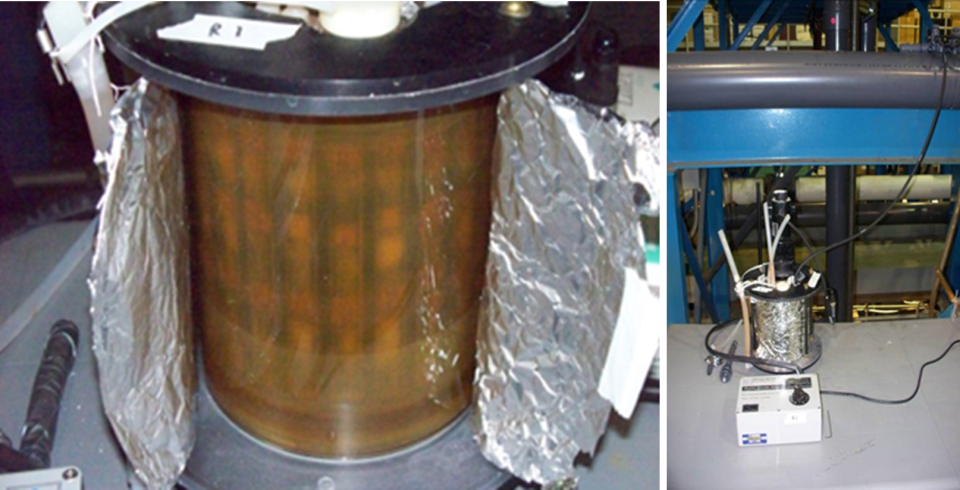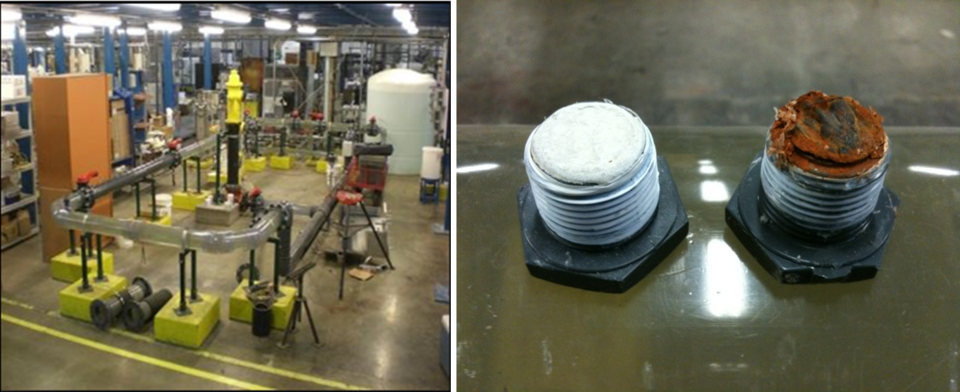Water Infrastructure Decontamination Bench and Pilot Scale Studies
The first step in understanding contaminant fate, transport and persistence on drinking water pipe materials is conducting experiments at the bench- and pilot-scales. Smaller systems allow many experiments to be conducted while generating less water and waste. EPA research at these scales takes place at EPA’s Test and Evaluation (T&E) facility in Cincinnati, Ohio. Examples of bench- and pilot-scale systems are listed below. These experiments employ removable “coupons” or pieces of pipe inner surfaces that can be sampled for the persistence of contaminants being researched, and what remains after decontamination.
Bench-Scale Decontamination Systems
Biofilm annular reactors are often used for bench-scale biofilm work since biofilm can be grown on many independent coupons, water quality can be controlled, and flow or shear characteristics can be controlled by how fast the inner drum rotates (pictured below).

Publications
- Efficacy of Chlorine Dioxide as a Disinfectant for Bacillus spores in Drinking Water Biofilms (2011) – This study tested whether chlorine dioxide disinfects Bacillus spores in the biofilm/corrosion matrix better than free chlorine.
- Persistence of non-native spore forming bacteria in drinking water biofilm and evaluation of decontamination methods (2011) – This study evaluated the persistence of Bacillus globigii spores on biofouled concrete-lined slides in drinking water using biofilm annular reactors.
- Data Set: Escherichia coli persistence on Unlined Iron in Chlorinated and Chloraminated Drinking Water (2010) – This data describes the persistence of Escherichia coli on corroded iron surfaces in chlorinated and chloraminated drinking water.
- Persistence and decontamination of surrogate radioisotopes in a model drinking water distribution system (2009) – Contamination of a model drinking water system with surrogate radioisotopes was examined with respect to persistence on and decontamination of infrastructure surfaces.
- Association and decontamination of Bacillus spores in a simulated drinking water system (2008) – This study examined the role of biofilm on the fate and disinfection susceptibility of Bacillus spores in a simulated drinking water system.
- Persistence and decontamination of Bacillus atrophaeus subsp. globigii spores on corroded iron in a model drinking water system (2007) – This study examined the persistence of Bacillus globigii spores on corroded iron coupons in drinking water using a biofilm annular reactor.
- Persistence of Klebsiella Pneumoniae on Simulated Biofilm in a Model Drinking Water System (2006) – This study evaluated the persistence of Klebsiella Pneumoniae on corroded iron surfaces in drinking water using biofilm annular reactors under oligotrophic conditions.
Pilot-Scale Decontamination Systems
A 75 ft long, six inch diameter pipe system is used for larger-scale drinking water distribution system decontamination studies (below left). Flow is the same as in a real distribution pipe, contaminants can be injected, and decontamination methods such as flushing or disinfection can be tested. Different infrastructure material surfaces such as unlined, corroded iron or cement-mortar can be tested by inserting coupons (below right) into the pipe so that the coupon surface is flush with the inner pipe surface.

Publications
- Disinfection and flushing of aircraft water systems (2018) – This project focused on identifying bacteria that are potential sources of positive total coliform assays, locating potential hotspots for bacterial colonization within aircraft plumbing materials, and investigating the effectiveness of the airline industry’s disinfection and flushing procedures.
- The effectiveness of disinfection and flushing procedures to prevent coliform persistence in aircraft water systems (2018) – Using a full-scale reproduction of an aircraft drinking water system, this study evaluated the persistence of coliform in aircraft water systems and the effectiveness of commonly used disinfection and flushing procedures.
- Persistence and decontamination of radioactive cesium in a model drinking water system (2018) – This study evaluated the persistence of radioactive cesium-137 on concrete-lined, copper, and polyvinyl chloride (PVC) pipe, and possible decontamination approaches.
- Decontamination of Bacillus spores adhered to iron and cement-mortar drinking water infrastructure in a model system using disinfectants (2017) – This study examined the effectiveness of decontaminating Bacillus globigii spores from common drinking water infrastructure surfaces such as corroded iron and cement-mortar with free chlorine, monochloramine, chlorine dioxide, ozone, peracetic acid and acidified nitrite, followed by flushing.
- Pilot-Scale Decontamination of Surrogate Radionuclides in a Pilot-Scale Drinking Water Distribution System (2016) – This study examined decontamination of non-radioactive cesium, strontium and cobalt salts (acting as chemical surrogates for cesium-137, cobalt-60, and strontium-90) in a pilot-scale drinking water distribution system of unlined, corroded iron and cement-mortar lined iron pipes.
- Radiological Contaminant Persistence and Decontamination in Drinking Water Pipes (2016) – This study tested EPA’s Persistence and Decontamination Experimental Design Protocol (PDEDP) to evaluate the persistence of cesium, cobalt, and strontium on concrete and polyvinyl (PVC) drinking water pipes and explore decontamination approaches.
- Chemical Contaminant Persistence and Decontamination in Drinking Water Pipes: Results using the EPA Standardized Persistence and Decontamination Experimental Design Protocol (2012) – The objective of this project was to develop and test a standardized Persistence and Decontamination Experimental Design Protocol (PDEDP) that could be used across laboratories to perform drinking water pipe decontamination research.
- Germinant-Enhanced Decontamination of Bacillus Spores Adhered to Iron and Cement-Mortar Drinking Water Infrastructure (2012) – This study examines the effectiveness of germinating Bacillus globigii spores adhered to iron and cement-mortar drinking water infrastructure and decontaminating with flushing and chlorination.
- Modeling and Simulation of Arsenate Fate and Transport in a Distribution System Simulator (2010) – This paper reports on bench-scale and pilot-scale experiments performed with distribution system simulators at EPA’s Test and Evaluation Facility.
- Bacillus Spore Uptake onto Heavily Corroded Iron Pipe in a Drinking Water Distribution System Simulator (2009) – This study examined the persistence of Bacillus globigii spores on unlined iron pipe surfaces in a drinking water system.
